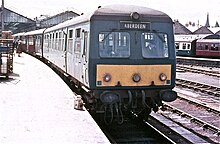British Rail Class 120
- 46 ft 6 in (14.17 m) (bogie centres)
- 8 ft 6 in (2.59 m) (bogies)[3]
- Dia 586: 36.50 long tons (37.09 t; 40.88 short tons)
- Dia 587: 36.35 long tons (36.93 t; 40.71 short tons)
- Dia 561: 30.60 long tons (31.09 t; 34.27 short tons)
- Dia 636: 36.95 long tons (37.54 t; 41.38 short tons)
- Dia 637: 37.05 long tons (37.64 t; 41.50 short tons)
- Dia 572: 30.15 long tons (30.63 t; 33.77 short tons)
- DD1 mk1 and mk2 (one of each)
- DD2 mk1 and mk2 (one of each)
- DT3 mk1 and mk2 (one of each)[3]
The British Rail Class 120 was a cross-country DMU in three-car formation, built at the British Rail Swindon Works.
History
Totalling 194 cars, three batches were built:
- 1958 - 49 sets for the Western Region
- 1959 - 7 sets for the Scottish Region
- 1961 - a further 9 sets for the Western Region
British Railways placed the order with British United Traction in summer 1956 for the equipment required for the 98 power cars and 47 trailers of the first batch. The order, along with equipment ordered by Cravens for 66 power cars and the 3 parcels cars, was valued at £830,000. The first batch was ordered for the WR's West Country dieselisation scheme, which it hoped to complete by the end of 1959. The sets were expected to work between Bristol & South Devon. Their general reliability and good braking characteristics made them popular with drivers.

In February 1959, the BTC placed an order with BUT for the equipment for the seven ScR sets, along with equipment for Class 108s and 127s being built at Derby. These 120s were to work mainly on the Aberdeen to Inverness line although appearances at Oban were not unknown. Otherwise the cars worked mainly in the Western and Midland Regions.
Some cars had a trial refurbishment but this was found to be too expensive, meaning an early withdrawal for most of the class. Some of the London Midland Region's units were transferred to Scotland in the mid-1980s, mainly finding use on local services from Edinburgh (notably to North Berwick). The final vehicles survived until 1989.
Fleet details
| Lot No. | Type | Diagram | Qty | Fleet numbers | Notes |
|---|---|---|---|---|---|
| 30334 | Driving Motor Second with lavatory (DMSL) | 586 | 49 | 50647–50695 | |
| 30335 | Driving Motor Brake Composite (DMBC) | 587 | 49 | 50696–50744 | |
| 30336 | Trailer Second Buffet (TSLRB) | 561 | 47 | 59255–59301 | |
| 30515 | Driving Motor Brake Composite (DMBC) | 636 | 9 | 51573–51581 | |
| 30516 | Driving Motor Second with lavatory (DMSL) | 637 | 9 | 51582–51590 | |
| 30517 | Trailer Second with lavatory (TSL) | 572 | 10 | 59579–59588 | |
| 30559 | Driving Motor Brake Composite (DMBC) | 587 | 7 | 51781–51787 | |
| 30560 | Driving Motor Second with lavatory (DMSL) | 586 | 7 | 51788–51794 | |
| 30561 | Trailer Second Buffet (TSLRB) | 561 | 7 | 59679–59685 |
Operation
From first introduction, units were based at Laira and operated several services in Cornwall including the Truro and Newquay Railway route via Perranporth.[10]
Accidents and incidents
- On 12 May 1978, the unit containing 51793-59684-51794, struck a lorry at Oyne and the front two cars were derailed. The unit was on the 07:43 Aberdeen to Inverness. Out of the 54 passengers on board, only 5 people suffered minor injuries.[11]
Other technical details
- Coupling Code: Blue Square
- Transmission: Standard mechanical
Preservation
One trailer car survives at the Great Central Railway: 59276 (TSLRB).
References
- ^ a b c "Class 120 Swindon 3-car DMUs: Numbering". Railcar.co.uk. Retrieved 24 February 2016.
- ^ a b c d "Class 120, 179". The Railway Centre. Archived from the original on 9 March 2005. Retrieved 24 February 2016.
{{cite web}}: CS1 maint: unfit URL (link) - ^ a b c d e f g h i j k Vehicle Diagram Book No. 220 for Diesel Multiple Unit Trains (Railcars) (PDF). Derby: British Railways Board. 1982. DP204, DP205, DQ101, DQ303, DQ304, DT210, DT217. Archived from the original (PDF) on 21 January 2015. Retrieved 24 February 2016 – via Barrowmore MRG.
- ^ Hemming 1978, pp. 5–9.
- ^ Fox 1987, pp. 10–11, 26, 33
- ^ Fairclough, Tony (1970). The story of Cornwall's railways. Truro: Tor Mark Press. p. 35.
- ^ Vaughan 1983, p. 56.
- ^ Vaughan 1983, p. 106.
- ^ Vaughan 1983, p. 87.
- ^ a b Heginbotham 2010, p. 56.
- ^ Rail Express, May 2018, Page 33.
Sources
- Fox, Peter (1987). Multiple Unit Pocket Book. British Railways Pocket Book No.2 (Summer/Autumn 1987 ed.). Platform 5 Publishing Ltd. ISBN 0906579740. OCLC 613347580.
- Heginbotham, Stephen (2010). Cornwall's Railways Remembered. Halsgrove. ISBN 978-0-85704-005-3.
- Hemming, R (August 1978). British Rail DMU/EMU Allocation book. National Railway Enthusiasts Association.
- Vaughan, John (1983). Diesels in the Duchy. Shepperton: Ian Allan. ISBN 0-7110-1326-8.
External links

- The Railcar Association – History of the Class 120 DMUs
- Picture of Class120[permanent dead link]
- v
- t
- e
(original TOPS)
(original TOPS)
designations










